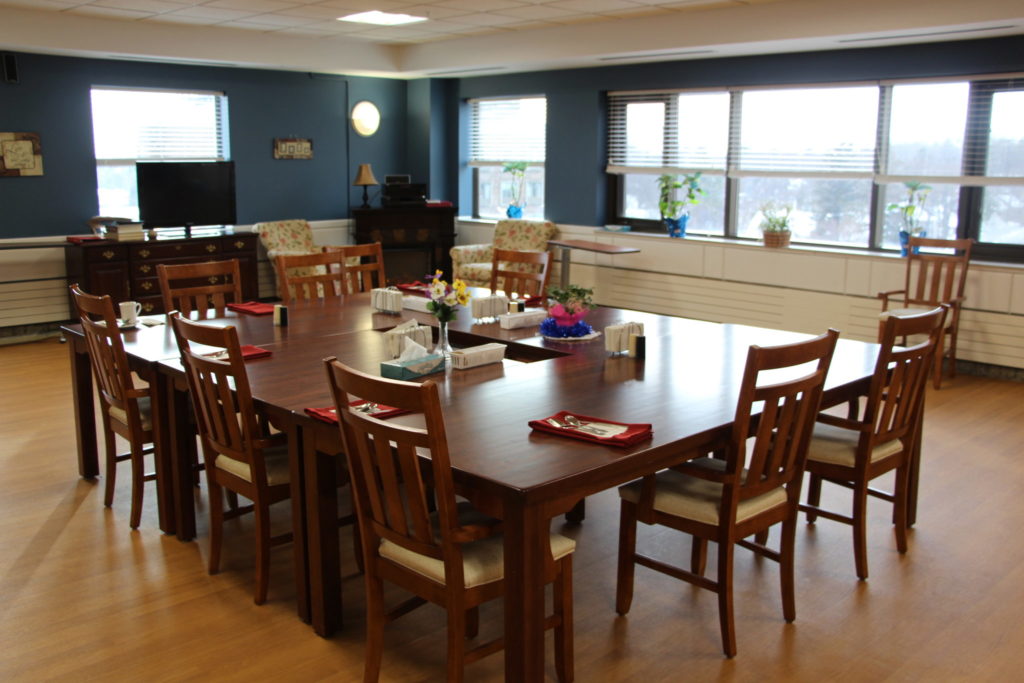Using the money it had already set aside for annual capital improvements, an upstate New York skilled nursing provider decided to bet big on a conversion to the “small house” model — and now it has some solid metrics to show for it, including an impressive jump in the proportion of private-pay residents.
About 10 years ago, the board at St. John’s Senior Services, a Rochester, N.Y.-based provider of senior living and skilled nursing services faced a crossroads: The SNF census was declining, and more and more potential residents were opting for rehab-focused facilities instead of the non-profit’s 475-bed, traditional long-term care space, according to Rebecca Priest, the vice president of skilled services.
Looking for a novel solution, St. John’s turned to the Green House Project, an organization that helped to develop the “small house” model: instead of a large institutional setting, Green House-inspired SNFs consist of small communities with an emphasis on home-like amenities, including private rooms with personal kitchens.
St. John’s had originally planned for 22 standalone small homes, but quickly found itself flummoxed by regulatory setbacks. Without being able to receive a certificate of need for the ambitious project, the provider had to de-certify a small portion of beds at its main facility to embark on a more limited plan of two homes, Priest said.
“It really imposed some organizational hardships,” Priest said. “The government wasn’t quite there.”
But despite the setbacks, the pared-back small home project reaped benefits for St. John’s: hospital readmissions currently sit at less than 1% for those facilities, Priest said, while both resident and employee satisfaction have increased.
Buoyed by these results, Priest and St. John’s decided to gradually convert the entire main campus — which consists of three connected, hospital-style buildings constructed in 1960, 1972, and 1995 — into the small home format. Without a vast cash reserve, Priest and the SNF board decided to simply invest the existing annual maintenance budget of $1.5 million into gradual upgrades that would eventually facilitate the conversion to a “small home.”
For instance, instead of maintaining the kitchen’s cafeteria-style equipment, St. John’s put the money into a vent system that would support individual household kitchens. Instead of re-carpeting hallways, the team chose flooring that could be divided into multiple rooms.
“It’s like any kind of home ownership,” Priest said. “You know where you want to take your house, but most of us don’t have $70,000 sitting in the bank to do all the things we want to our house at one time.”
That said, the plan wasn’t without drawbacks: certain maintenance needed to be deferred in favor of the long-term preparations, and Priest noted that the strategy represented a “big leap of faith.”
“You picked one project over the other because you were moving toward an endgame,” she said.
That endgame is in sight. The 1972-built structure is slated to be completely converted by the end of the year, Priest said, with a 2019 finish line for the other two structures. And St. John’s has already started reaping the benefits. Prior to the conversion, private-pay residents — a coveted customer for SNF operators, given the lack of Medicare and Medicaid reimbursement issues — accounted for about 16% of the overall census, according to Priest. Now, they represent about 26%.
“It’s given us the nimbleness to respond to the market,” Priest said, adding that the “small home” model allows St. John’s to seamlessly integrate rehab residents into long-term units if the dedicated rehab spaces are full — something that was previously impossible in the hospital-style units.
They’ve also increased satisfaction, Priest said, by giving residents more control over their lives.
“People wanted the product,” she said.
(Pictured: A communal dining room at St. John’s. Credit: Courtesy photo.)
Written by Alex Spanko



